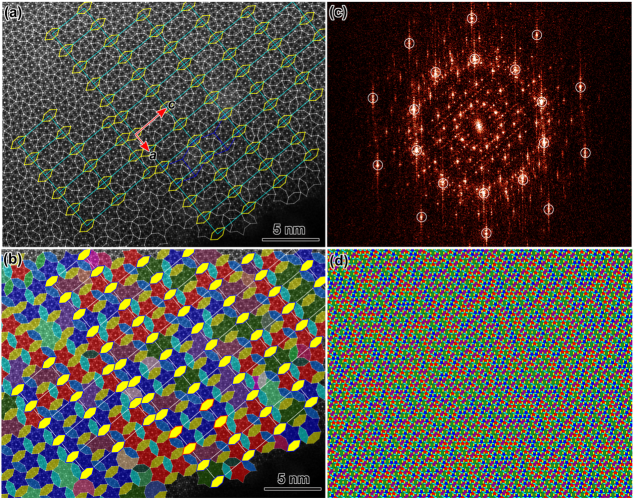Recently, one new solid state related with quasicrystals was discovered by Zhanbing He at State Key Laboratory for Advanced Metals and Materials, University of Science and Technology Beijing, Junliang Sun, College of Chemistry and Molecular Engineering, Peking University, Xiuliang Ma, Shenyang National Laboratory for Materials Science, Institute of Metal Research, Chinese Academy of Sciences, and Walter Steurer, Department of Materials, ETH Zurich, Switzerland. It is a special mosaic of aperiodically distributed unit tiles in translationally periodic structural blocks, which means it contains the structural features both of periodic crystals and of quasicrystals, other than any reported intermediate states between them. In other words, this novel structure accommodates the concordant coexistence of the translational symmetry of conventional crystals and the aperiodicity of quasicrystals, which was previously considered impossible. Therefore, it provides an ingenious solution in crystal structure to reconcile the contradictions between quasicrystals and conventional crystals. Authors believe that it might trigger wide interest to it in theory, experiments, and potential applications. For details, please see the original paper by Zhanbing He, Yihan Shen, Haikun Ma, Junliang Sun, Xiuliang Ma, Hua Li, Walter Steurer, quasicrystal-related mosaics with periodic lattices interlaid with aperiodic tiles, Acta Cryst. (2020), A76, 137–144. Link: https://doi.org/10.1107/S2053273320000066.
This novel quasicrystal-related solid state was discovered experimentally in Al-Cr-Fe-Si alloys, and the structural characterizations at an atomic resolution were revealed by Cs-corrected transmission electron microscope. Figure 1 gives a typical example of this new solid state. The yellow hexagonal (H) tiles in Fig. 1a are arranged on the periodic grid (in blue), where the lattice parameters of the periodic grid of yellow H tiles are a = 1.90 nm, and c = 3.61 nm, similar to those of the (2/1, 3/2) approximant of quasicrystal. The structural characteristics are revealed intuitively in Fig. 1b when all the structural blocks are colored according to their orientations. In general, the structural blocks inserted in-between the space of periodic H tiles (in yellow in Fig. 1b) are arranged aperiodically through the combination of two oriented star (S) tiles, three oriented H tiles, four oriented dumbbell-like tetradecagons (DLTs), and they are also mixed with some different oriented boat (B) tiles. Note that few unit cells of the (2/1, 3/2) approximant could be achieved locally because of the locally periodic H and S tiles in the matrix of the mosaic, suggesting the generation of this structure is closely related with the (2/1, 3/2) approximant. In Fig. 1c, ten strong diffraction spots appear in the fast Fourier transform of Fig. 1a, which implies the close structural relationship to the quasicrystals. Although quasicrystal-related nanodomains have been often observed, they are either arranged randomly, microcrystalline or as crystal nuclei of approximants, or form metadislocations, all of them clearly different from the structure mentioned here. This special structures is by no means restricted to the types found experimentally. The combination of different periodic tiles, different lattice parameters, and the accompanying aperiodic tiles in abundant quasicrystal-related systems can lead to a variety, thereby suggesting their universal property. For example, a further example with a larger size is built from geometric point of view, based on the structural blocks mentioned above, as seen in Fig. 1d.
Authors mentioned that this special aperiodic crystal is different from the procrystalline, incommensurately modulated structures, and quasicrystals. Compared to the one-dimensional nanotubular host–guest structure with aperiodic guest molecules embedded into a periodic host, it provides a striking two-dimensional example that accommodates the aperiodic and periodic structures simultaneously. Although it was found in alloys, it could exist in lots of materials such as in porous materials, molecular- or nano-assembly systems. Authors believe that this finding might provide insight into the design of materials, especially for those where their properties are closely related with the periodicity, for example photonic crystals, and artistic tilings in architecture.

Figure One new solid state. (a), (b) The structural details of this novel structure are revealed by atomic resolution high-angle annular dark-field (HAADF) scanning transmission electron microscopy (STEM) images. The yellow H tiles are positioned periodically on the blue periodic grid with the same a, and c parameter of (2/1, 3/2) approximant, and the aperiodic tiles are displayed in the spaces in-between the periodic H tiles in (a). (c) Fast Fourier transform of (a), where strong diffraction spots have tenfold symmetry, implying the close structural relationship to the corresponding DQC. (d) A program generated structure built from H, S and DLT tiles, where yellow H tiles are periodic. Aperiodic H tiles, S tiles and DLT tiles stacks in-between the periodic yellow H tiles. The combination of different periodic tiles, different lattice parameters, and the accompanying aperiodic tiles can lead to a variety, thereby suggesting their universal property.